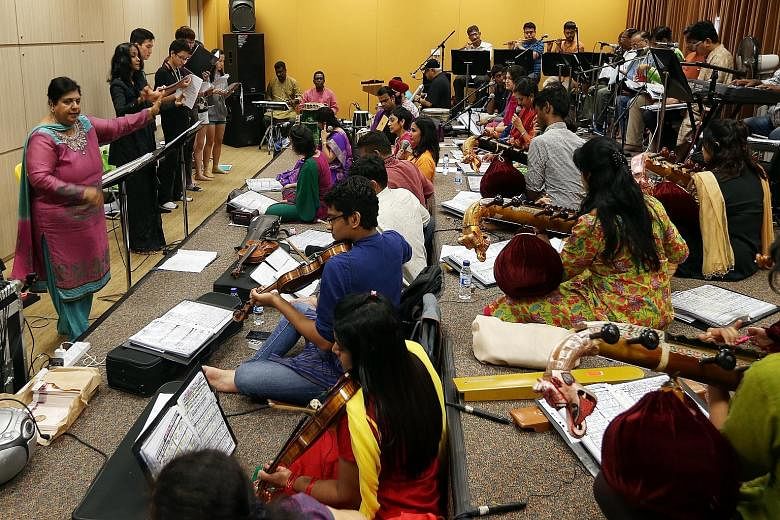A last-minute job at the age of 15 set Mrs Lalitha Vaidyanathan on a new musical course.
She was asked to play the violin accompaniment when her elder sisters, both Carnatic vocalists, sang during the nine-day Navaratri festival devoted to the deity Durga. In the process, her eyes were opened to the possibilities of fusing Western music techniques with Eastern sounds.
Mrs Vaidyanathan, 66, is now conductor of the Singapore Indian Orchestra and Choir, which holds its 30th anniversary concert at the Esplanade tomorrow.
A pioneer in the field of orchestration and fusion Indian music, she has helmed the over 30-strong ensemble of musicians and singers since 1985. "When you stifle them with just one option, they can't really grow much," she says.
She recalls one review in 2001, which called her attempt to perform Antonio Vivaldi's iconic Four Seasons Summer violin concerto in the style of Carnatic music composer Tyagaraja "an experiment gone wrong".
-
BOOK IT/INNISAI NINAIVUGAL - MUSICAL MEMORIES
-
WHERE: Esplanade Theatre
WHEN: Tomorrow, 7pm
ADMISSION: $25 and $35 from Sistic (call 6348-5555 or go to www.sistic.com.sg)
She defends her experimental choice: "It must be pleasing to the ear, it must be pleasing to the audience, that's all that matters."
The orchestra will be revisiting its Vivaldi-meets-Tyagaraja interpretation at Sunday's concert.
The youngest of six children from a performing arts family - two sisters were trained as classical Indian dancers and veena players, while her brother was a mridangam drum player - Mrs Vaidyanathan learnt the instrument till grade five.
After her musical epiphany at age 15, she went in pursuit of a bigger, unprecedented sound.
Carnatic music ensembles are small, usually comprising a principal vocalist, a percussionist, a flautist and melodic accompaniment in the form of a violin. She says: "I wanted to do Indian orchestration, but I didn't know how to do it."
After getting her degree in chemistry from the then University of Singapore, she worked as a quality controller before becoming a chemistry teacher in 1978.
She also took a crack at music orchestration with the Ramakrishna Sangeetha Sabha Orchestra that year. The following year, she led it to a first prize award at the National Music Competition, organised by the National Arts Council.
During her tenure at this orchestra, she met and married her husband, an offshore oil engineer, and had two daughters.
She helmed the orchestra until 1983. Then in 1985, the People's Association (PA) asked her to form a pop orchestra, but she refused.
Instead, she wanted to attempt popularising Carnatic music among the non-Indian community with her experience in both traditional classical Indian music and Western harmonies.
"They gave me leeway to take it in the direction I wanted," she says.
Hence, the Singapore Indian Orchestra and Choir was born. She held Sunday practice sessions at the PA headquarters in King George's Avenue every week, even while holding her full-time teaching job.
She used to play the violin while conducting, until an injury in the early 2000s prevented her from playing it in the seated style of traditional Carnatic music.
Though Indian music is a male- dominated field, it was never a stumbling block for her. "It didn't matter whether I was male or female. It never occurred to me that I couldn't go far in music."
Looking ahead, she wants the orchestra to be a full-fledged unit with a permanent space one day and a full-time ensemble supplemented by part-timers. "Once that is in place, it can grow from there."


